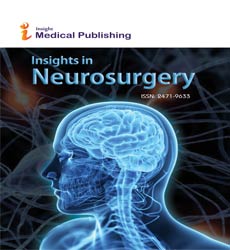Role of Neuroendoscopy in the Field of Neurosurgery
Laurence Jacobs
Laurence Jacobs*
Department of Neurology, University of Houstan, Houstan, Texas, USA
- *Corresponding Author:
- Laurence Jacobs
Department of Neurology,
University of Houstan,
Houstan,
Texas,
USA,
E-mail: laure.jacob@ces.edu
Received Date: November 12, 2021 Accepted Date: November 26, 2021 Published Date: December 3, 2021
Citation: Jacobs L (2021) Role of Neuroendoscopy in the Field of Neurosurgery. Neurosurg. Vol.5 No.S1:e002.
Description
Neuroendoscopy has emerged as a precious technologic adjunct in the treatment of numerous neurosurgical conditions. Neuroendoscope is used to perform common procedures such as endoscopically guided shunt placement, membrane fenestration, and tumor management.
To date, maximum neuroendoscopic procedures involve the fenestration of intraventricular cysts or membranes and the biopsy or discarding of intraventricular tumors. In most cases, obstructive hydrocephalus accompanies these conditions and produces symptoms of increased intracranial pressure, generally including headache and vomiting, although accelerated head growth may be the only presenting symptom in neonates or babies.
Ultrasound or computed tomography (CT) generally is performed as a screening study to diagnose these conditions. Characteristic images demonstrate hydrocephalus alone or accompanied by intraventricular tumors or cystic membranes. Magnetic resonance imaging (MRI) should be performed previous to any neuroendoscopic procedure because it provides the best anatomic detail of the surrounding vasculature and adjacent brain structures. Preoperative contrast ventriculography should be performed in cases of complex hydrocephalus to assess communication between compartments within the ventricular system. No other diagnostic studies are required previous to neuroendoscopic surgery.
Essential factors for performing surgery include an endoscope, either rigid or flexible, light source, camera, viewing monitor, irrigation pump, and instrumentation for dissection and coagulation. Generally, the factors are assembled on a wheeled cart, or they may be manufactured in a unitized system. Rigid endoscopes are preferred to fiberscopes because of their superior optics and multiple ports for irrigation and suction. Rigid endoscopes are tricky to maneuver through the ventricles when performing multiple fenestrations and need strategic targeting of the first burr hole. Fiberscopes supply greater project with lower strategic planning but compromise optic clarity and image quality. In numerous procedures, both types of endoscope may be used. Although the instrumentation for performing endoscopic surgery is limited, specific instruments are available to perform biopsy, to dissect, and to coagulate tissue. Cup forceps are essential for tissue biopsy and for grasping foreign bodies within the ventricular system. Small balloon catheters are available to enlarge small fenestrations created in the septum pellucidum, the bottom of the third ventricle, or walls of obstructing cysts. Fiber optic lasers and monopolar electrodes may be used as energy sources to coagulate tumors or membranes and to dissect tissue. Both have been used successfully, but the advanced cost of laser fibers and the concern about heat dissipation from the laser have favored the emergence of a monopolar electrode as the favored device in neuroendoscopic surgery.
Creation of a ventriculoperitoneal shunt is a common procedure in pediatric neurosurgery, there's considerable controversy regarding the optimal position for entering the ventricular system. Ventricular catheter is preferred to place from the anterior or coronal approach. A small pen neuroendoscope may be used for optimal positioning of the intraventricular catheter. Intraventricular tumors can be safely biopsied or excised on the basis of their size, vascularity and position. Utmost excrescences can be approached through an anterior or occipital purr hole. Tumors larger than 3 cm in diameter are best managed through conventional surgical ways because endoscopic devices for rapidly debulking larger tumors either haven't been developed or aren't adequately tested to determine their utility. A rigid endoscope is best suited for tumor removal because of multiple working channels and its superior optics.
Neuroendoscopy clearly has the potential to avoid numerous shunts and to minimize surgical trauma and served neurologic surgery greatly. Neuroendoscopy provides the surgeon a safe and effective means of treatment and has turned an essential tool in the treatment of hydrocephalus, cysts and intraventricular masses. Fresh remedial operations for neuroendoscopy will probably arise with greater specialized advancements. Till now numerous cases have reported the advantages of minimally invasive surgery in reducing operating times and hospitalizations. It's accompanied by confined capability to suction and coagulate but if used with great care, its implicit mainly outweighs its risks.
Open Access Journals
- Aquaculture & Veterinary Science
- Chemistry & Chemical Sciences
- Clinical Sciences
- Engineering
- General Science
- Genetics & Molecular Biology
- Health Care & Nursing
- Immunology & Microbiology
- Materials Science
- Mathematics & Physics
- Medical Sciences
- Neurology & Psychiatry
- Oncology & Cancer Science
- Pharmaceutical Sciences
